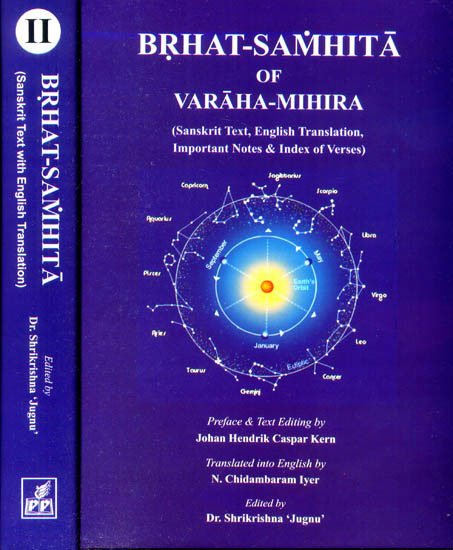Brihat Samhita
by N. Chidambaram Iyer | 1884 | 135,584 words | ISBN-13: 9788171104215
This page describes the constellation of saptarshi (seven rishis or sages) which is the thirteenth Chapter of the English translation of the Brihat-samhita. This work, written by Varahamihira in the 6th century, is classified as jyotisha literature, also known as Indian astronomy. It contains however, also content regarding astrology, palmistry, agriculture, gardening, perfumes, medicines and various other encyclopedic topics.
Chapter 13 - On the constellation of Saptarṣi (seven Ṛṣis or Sages)
[Sanskrit text for this chapter is available]
1. I shall now expound about the movements of the Seven Ṛṣis (Saptarṣi), through whom the northern region shines as though bedecked with a pearl necklace, like a maiden with a smiling countenance wearing a garland of white lotuses.
2. Or by the direction of her lord—the Pole-Star (Seven Ṛṣis), the northern maiden (quarter) appears to dance round as the Seven Ṛṣis move in their course. I begin to treat of these stars adopting the views of Vṛddha Garga.
3. During the reign of Yudhisthira[1], 2526[2] years before the commencement of Vikrama Śaka, the Seven Ṛṣis (Saptarṣi) were at the constellation of Maghā (Regulus).[3]
4. The Ṛṣis take a period of 100 years to go over each of the 27 asterisms.[4] They rise in the north-east and are accompanied by the chaste Arundhatī—the consort of Vasiṣṭha.[5]
5. The eastern-most of the group is Bhagavān Marīci; the next to him is Vasiṣṭha; the next is Aṅgiras and the next two are—Atri and Pulastya.
6. The next in order are the Ṛṣis—Pulaha and Kratu. The chaste Arundhatī closely attends her husband the sage Vasiṣṭha.[6]
7. If the Ṛṣis should be crossed by meteoric falls, thunderbolts or comets, or if they should appear dim or without rays or of very small disc, they will cause misery and suffering to the persons and objects they severally represent; but if they should appear big or bright there will be happiness and prosperity.
8. If Marīci should be affected as described above the Gandharvas, the Devas, the Asuras, skilled magicians and physicians, the Yakṣas, the Nāgas and the Vidyādharas will also be afflicted.
9. If Vasiṣṭha should be crossed by meteoric falls or otherwise affected, the Scythians, the Yavanas, the Daradas, the Pāratas, the people of Kāmboja and the Ṛṣis of the forests will suffer; but if Vasiṣṭha should appear bright, he will cause happiness.
10. If Aṅgiras should be affected as described above, men of knowledge, men of actual intellect and Brāhmaṇas will be afflicted; if Atri should be so affected, the products of the forests and of water, seas and rivers will suffer.
11. Along with Pulastya will suffer the Rākṣasas, the Piśācas, the Asuras, the Daityas and the Nāgas. Along with Pulaha will suffer roots and fruits; and along with Kratu will suffer sacrificial rites and persons performing them.
Footnotes and references:
[1]:
Yudhiṣṭhira, otherwise known as Dharmaputra, the eldest of the Pāṇḍus who flourished at the end of the Dvāparayuga.
[2]:
2526, i.e. nearly 4,500 years ago. The reader will note that at this early period at least, if not earlier still, the Hindus were noted for their knowledge of Astronomy and that they had recognized the motions of the stars, speaks highly of their powers of observation.
[3]:
Regulus: vide last note to the next stanza.
[4]:
An asterism is 13°. 20' of the ecliptic: at the rate of 100 years each the Ṛṣis take 2,700 years to make a circuit of the heavens.
[5]:
The Ṛṣis are said to be in that constellation of the ecliptic with which the western most two either rise at Laṅkā (equator) or culminate at the meridian. In Viṣṇu Purāṇa, it is stated that when the observation was made at one time, the two Ṛṣis were found in Maghā. The Purāṇa also states that when the Ṛṣis should reach the constellation of Pūrvāṣāḍha passing over a space of 10 asterisms in 1015 years, the Nandas will reign.
[6]:
Vasiṣṭha, as already observed, is the last star but one. What is pointed out as Arundhatī near Vasiṣṭha is not the real Arundhatī; she is declared in the Śāstras to be a Sūksma Tārā (telescopic star) very close to Vasiṣṭha.
